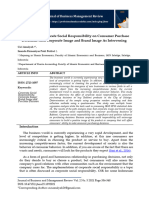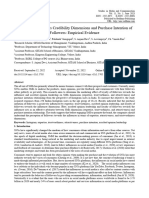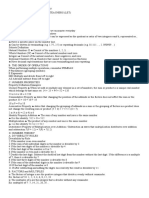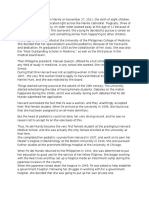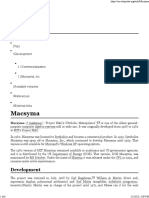The Influence of Social Media Communication Produc
The Influence of Social Media Communication Produc
Uploaded by
K60 Lê Phạm Yến ThyCopyright:
Available Formats
The Influence of Social Media Communication Produc
The Influence of Social Media Communication Produc
Uploaded by
K60 Lê Phạm Yến ThyOriginal Title
Copyright
Available Formats
Share this document
Did you find this document useful?
Is this content inappropriate?
Copyright:
Available Formats
The Influence of Social Media Communication Produc
The Influence of Social Media Communication Produc
Uploaded by
K60 Lê Phạm Yến ThyCopyright:
Available Formats
Almana : Jurnal Manajemen dan Bisnis
Volume 6, No. 3/ December 2022, p. 472-479
ISSN 2579-4892 print/ ISSN 2655-8327 online
DOI: 10.36555/almana.v6i3.1935
THE INFLUENCE OF SOCIAL MEDIA COMMUNICATION, PRODUCT QUALITY,
AND PROMOTION ON PURCHASE INTENTION
Ida Ayu Nyoman Ari Cendani Wati1, Ni Luh Putu Indiani*2
Universitas Warmadewa, Indonesia1*2
cendani@gmail.com1, indi.arca@gmail.com*2
Abstract: In the last 10 years, Indonesia's beauty and personal care industry grew
around 12%, with a market value of 33 trillion Rupiah in 2016. The business in Indonesia
is predicted to experience the largest growth compared to other countries in Southeast
Asia. This raises interest in analyzing the factors influencing consumer purchase
intention in body care products. The purpose of this study was to analyze the influence
of social media communication, product quality, and promotion on purchase intention.
The data collection method is a survey method with questionnaires. The sample size
was 105 respondents. Multiple linear regression analysis techniques were used to test
the influence of the independent variable on the dependent variable. The study's results
found that social media communication, product quality, and promotion positively and
significantly influence purchase intention. The brand needs to build good relationships
with consumers through social media to encourage purchase intention. In terms of
quality, the brand should be able to create a unique and distinctive quality that
consumers can accept. In the promotion aspect, the brand should show a responsible
attitude when complaints occur, such as providing a money-back guarantee.
Keywords: Product Quality; Promotion; Purchase Intention; Social Media
Communication
INTRODUCTION
The era of globalization is a challenge that must be faced with careful preparation
by the company. Companies must be prepared as well as possible not to be crushed by
world globalization. In developing their business, firms must be more creative and
innovative. Profit is the main focus of entrepreneurship because, without profit, a
company will not be able to survive. In the last 10 years, Indonesia's beauty and personal
care industry grew by around 12%, with a market value of 33 trillion Rupiah in 2016. The
business is predicted to experience the largest growth in Indonesia compared to other
countries in Southeast Asia (Majalah Kartini, 2017). The national cosmetic industry
recorded an increase of 20%, or four times the national economic growth in 2017. This
double-digit growth increase was driven by large demand from the domestic and export
markets as people began to pay attention to personal care products as a primary need,
especially for women, adults, and millennials. Currently, various businesses provide
personal care products, one of which is the brand Mooika.
In meeting market demand, Mooika focuses on body care products that can solve
the problems experienced by consumers. At the beginning of 2018, Mooika revenue
exceeded the target by 102% due to high consumer demand for body care products.
However, in 2019 revenue fell to 74%, and in 2020 it fell again to 73%. This indicates a
problem in consumer purchase intention for Mooika's products. For this reason, the
authors are interested in examining the factors influencing consumer purchase intention
in Mooika products.
Purchase intention is customer behavior that responds positively to the quality of
a company's products or services and intends to buy back the company's products.
Purchase intention is the stage of the respondent's tendency to act before the buying
Submitted: September 03, 2022; Revised: October 18, 2022;
Accepted: October 25, 2022; Published: December 25, 2022;
Website: http://journalfeb.unla.ac.id/index.php/almana/article/view/1935
472
Almana : Jurnal Manajemen dan Bisnis
Volume 6, No. 3/ December 2022, p. 472-479
ISSN 2579-4892 print/ ISSN 2655-8327 online
DOI: 10.36555/almana.v6i3.1935
decision is implemented. It can be concluded that purchase intention is one of the
planning processes for purchasing a product or service that consumers will carry out by
considering several things. Purchase intention can be measured through the following
indicators: transactional intention, referential intention, preferential intention, and
exploratory intention (Wicaksono, 2017). From the literature review, one of the factors
that influence purchase intention is social media communication.
Social media communication is an activity or activity of communicating and
providing product information using social media such as Instagram. Social media can
also make it easier for entrepreneurs to explain and display product reviews and
information. Currently, social media users continue to increase every year. Several
previous studies have proven that social media has a positive and significant influence
on purchase intention, as found by (Ariesandy & Zuliestiana, 2019), (Irawan, 2020),
(Hartiani, 2020), (Arianto & Difa, 2020), (Setiawan, 2020). There are four indicators to
measure social media communication (Hauner & Syahbani, 2017), namely: 1) Context
is how we create a message that uses language that is easy to understand, 2)
Communication is how the message or information that has been made can be heard,
responded to and grown in various ways that make the user feel comfortable, and the
message is conveyed well 3) Collaboration is a cooperation between users to make
things better, 4) Connection is a way of maintaining relationships that have been
established to become a better relationship.
In addition to social media communication, product quality also influences
consumer purchase intention. Product quality is the ability of a product to perform its
functions, including overall durability, reliability, accuracy, ease of operation, and product
repair, as well as other product attributes (Kotler & Armstrong, 2012). Several previous
studies have proven that product quality has a positive and significant influence on
purchase intention, as found by (Ariesandy & Zuliestiana, 2019), (Irawan, 2020),
(Hartiani, 2020), (Arianto & Difa, 2020), (Setiawan, 2020). (Garvin, 2016) mentioned the
dimensions of product quality: performance, product features, reliability, conformance,
durability, serviceability, aesthetics, and perceived quality.
The third factor that influences consumer purchase intention is promotion. The
promotion aspect is the main thing in running a business. Promotion is communication
between buyers and sellers. Several previous studies have proven that promotion has a
positive and significant influence on purchase intention, as found by (Nova et al., 2021),
(Hartiani, 2020), (Gunawan & Susanti, 2019), (Kuspriyono, 2017), (Sigalingging &
Medicom, 2021). Promotion is measured using three indicators: informing consumers
about the product, persuading consumers to try the product, and reminding consumers
about the offering.
Purchase intention is important amid intense competition to gain customer trust,
so they continue to buy the products. Based on this background, the authors are
interested in analyzing consumer purchase intention by examining the influence of social
media communication, product quality, and promotion.
METHODS
This research was conducted at Mooika's body care business in Denpasar, Bali.
The population in this study were all customers who purchased Mooika body care.
According to Sugiyono (2018), the determination of the number of representative
samples is the number of indicators multiplied by 5 to 10. In this study, there are 21
indicators, so the number of samples used is 5 x 21 the number of indicators, hence
becoming 105 respondents. The sampling technique used is accidental sampling, that
is, anyone who happens to meet the researcher can be used as a sample if it is
Submitted: September 03, 2022; Revised: October 18, 2022;
Accepted: October 25, 2022; Published: December 25, 2022;
Website: http://journalfeb.unla.ac.id/index.php/almana/article/view/1935
473
Almana : Jurnal Manajemen dan Bisnis
Volume 6, No. 3/ December 2022, p. 472-479
ISSN 2579-4892 print/ ISSN 2655-8327 online
DOI: 10.36555/almana.v6i3.1935
considered suitable as a data source. The data collection method used in this study was
a questionnaire survey method. Each statement item is measured on a Likert scale,
using five numbers from 1 (strongly disagree) to 5 (strongly agree). The data analysis
technique used in this study is a multiple linear regression analysis method. Multiple
linear regression analysis measures independent variables' influence on dependent
variables (Sugiyono, 2018).
RESULTS AND DISCUSSION
Validity Test
The validity test results are shown in Table 1, which shows that all the correlation
coefficients of the tested variable indicators are greater than 0.30. These results indicate
that all indicators of this study proved valid.
Table 1. Validity Test
Pearson
Variable Instrument Remark
Correlation
Content on Instagram creates a sense of satisfaction 0.796 Valid
Consumers are always waiting for the latest
0.660 Valid
information on Instagram
Consumers trust the information shared on Instagram 0.374 Valid
Social
Consumers feel a good relationship with Mooika
Media 0.437 Valid
through social media
(X1)
Mooika interacts well with consumers through social
0.718 Valid
media
Mooika interacts well with consumers after
0.578 Valid
consumers make product purchases
Products provide benefits 0.718 Valid
Products have a fairly long expiration date and do not
0.573 Valid
affect the quality
Consumers get products that match their
Product 0.559 Valid
expectations
Quality
Products provide added value and different features
(X2) 0.762 Valid
compared to other products
Products do not disappoint 0.686 Valid
Attractive product packaging 0.574 Valid
Consumers feel satisfied after using the products 0.631 Valid
Mooika advertises intensively on various social media 0.732 Valid
Mooika's communication approach can attract
0.593 Valid
consumers to buy the products
Promotion
Mooika often provides promotions by giving discounts
(X3) 0.770 Valid
or giving free products to consumers
Mooika provides clarification or explanation if there
0.774 Valid
are consumer complaints
Consumers are interested in buying Mooika products 0.765 Valid
Consumers are willing to refer Mooika products to
0.849 Valid
Purchase others
Intention Consumers prefer to use Mooika products compared
0.775 Valid
(Y) to similar products from other brands
Consumers are always looking for information about
0.822 Valid
Mooika products
Source: Data that has been processed by the author (2022)
Submitted: September 03, 2022; Revised: October 18, 2022;
Accepted: October 25, 2022; Published: December 25, 2022;
Website: http://journalfeb.unla.ac.id/index.php/almana/article/view/1935
474
Almana : Jurnal Manajemen dan Bisnis
Volume 6, No. 3/ December 2022, p. 472-479
ISSN 2579-4892 print/ ISSN 2655-8327 online
DOI: 10.36555/almana.v6i3.1935
Reliability Test
The reliability test results in Table 2 show that each variable's Cronbach's Alpha
value is greater than 0.60. This shows that all variables have good reliability.
Table 2. Reliability Test
Variable Cronbach's Alpha Information
Social Media (X1) 0.614 Reliable
Product Quality (X2) 0.744 Reliable
Promotion (X3) 0.687 Reliable
Purchase Intention (Y) 0.813 Reliable
Source: Data that has been processed by the author (2022)
Table 2 shows that Cronbach's Alpha value of social media variables is 0.614,
product quality is 0.744, promotion is 0.687, and purchase intention is 0.813. The
reliability results show that Cronbach's Alpha of all research variables is worth more than
0.6. Based on these results, it can be concluded that the instrument used in this study is
reliable or trustworthy.
Coefficient Determination Analysis
Table 3. Adjusted R-Square
Model Summary
Model R R Square Adjusted R Square Std. Error of the Estimate
1 .752a .565 .553 .45792
a. Predictors: (Constant), Promotion, Social_Media, Product_Quality
Source: Data that has been processed by the author (2022)
The Adjusted R-Square value of this regression model is 0.553, which means that
social media, product quality, and promotion explain 55.3 percent of the variation in
purchase intention, and the remaining 44.7 percent is explained by other variables not
included in the model.
F-Test
Table 4. F-Test Results
ANOVAa
Model Sum of Squares Df Mean Square F Sig.
1 Regression 27.560 3 9.187 43.810 .000b
Residual 21.179 101 .210
Total 48.739 104
a. Dependent Variable: Purchase_Intention
b. Predictors: (Constant), Promotion, Social_Media, Product_Quality
Source: Data that has been processed by the author (2022)
The magnitude of Ftable = F (α, df1/df2) therefore the value sought is F (0,05,3/101).
Based on the distribution the value of Ftable = 2.69. Based on the Ttable the Fcount value is
43,810 with a significance value of 0.000. F count > Ftable = 43,810 > 2.69 then Ho is rejected
and Ha is accepted. The results of this F-test indicate that with an error rate of 5 percent
and a confidence level of 95 percent, there is a simultaneous significant effect of social
media (X1), product quality (X2), and promotion (X3) on purchase intention (Y).
Submitted: September 03, 2022; Revised: October 18, 2022;
Accepted: October 25, 2022; Published: December 25, 2022;
Website: http://journalfeb.unla.ac.id/index.php/almana/article/view/1935
475
Almana : Jurnal Manajemen dan Bisnis
Volume 6, No. 3/ December 2022, p. 472-479
ISSN 2579-4892 print/ ISSN 2655-8327 online
DOI: 10.36555/almana.v6i3.1935
T-Test
Table 5. T-Test Results
Model T Sig.
1 (Constant) .301 .764
Social_Media 7.860 .000
Product_Quality 2.312 .023
Promotion 4.281 .000
a. Dependent Variable: Purchase_Intention
Source: Data that has been processed by the author (2022)
The amount of Ttable = t (α, df) therefore, the value sought is t(0,05,101). The value
of the Ttable = 1.660. Based on the table, the Tcount value of social media is 7,860 (X1)
greater than Ttable 1.660 and shows a significant value < = 0.000 <0.05 then Ho is rejected
and H1 is accepted. This shows that social media has a positive and significant effect on
purchase intention with an error rate of 5 percent, and 95 percent confidence. The Tcount
of product quality is 2,312 (X2) greater than the Ttable of 1,660 and shows a significant
value < = 0.023 < 0.05 then Ho is rejected and H2 is accepted. This shows that product
quality has a positive and significant effect on purchase intention with an error rate of 5
percent, and 95 percent confidence. The Tcount value of the promotion is 4.281 greater
than Ttable 1.660 and shows a significant value < = 0.000 <0.05 then Ho is rejected and
H3 is accepted. This shows that promotion has a positive and significant effect on
purchase intention at Mooika with an error rate of 5 percent, and 95 percent confidence.
Multiple Linear Regression Analysis
Table 6. Results of Regression Analysis
Coefficientsa
Unstandardized Coefficients Standardized Coefficients
Model t Sig.
B Std. Error Beta
1(Constant) .096 .319 .301 .764
Social media .817 .104 .627 7.860 .000
Product Quality .249 .108 .193 2.312 .023
Promotion .401 .094 .349 4.281 .000
a. Dependent Variable: Purchase Intention
Source: Data that has been processed by the author (2022)
Social Media Communication (X1) = 0.627, indicating that the regression
coefficient of social media (X1) is positive, meaning that if social media is well-executed,
it will encourage purchase intention.
Product quality (X2) = 0.193, indicating that the regression coefficient of product
quality (X2) is positive, meaning that better product quality will increase purchase
intention.
Promotion (X3) = 0.349, indicating that the regression coefficient of promotion
(X3) is positive, meaning that if the promotion is more intensively carried out, it will
encourage an increase in purchase intention. Social media communication has the
largest regression coefficient value among other variables, so it can be concluded that
social media has a more dominant influence on purchase intention than other variables
in the model.
Submitted: September 03, 2022; Revised: October 18, 2022;
Accepted: October 25, 2022; Published: December 25, 2022;
Website: http://journalfeb.unla.ac.id/index.php/almana/article/view/1935
476
Almana : Jurnal Manajemen dan Bisnis
Volume 6, No. 3/ December 2022, p. 472-479
ISSN 2579-4892 print/ ISSN 2655-8327 online
DOI: 10.36555/almana.v6i3.1935
The Influence of Social Media Communication on Purchase Intention
The better the management and use of social media to provide product
information, the higher consumers' purchase intention. The results of this study are in
line with research conducted by (Nurfitriani, 2017), (Astutik, 2018), (Susilawati &
Purwantoro, 2015), (Fidyah, 2017), (Melliana, 2018) and (Ariesandy & Zuliestiana, 2019)
which state that social media communication has a significant impact on purchase
intention. Aspects that need to be considered in increasing the influence of social media
are ensuring that information and content uploaded through Instagram creates a sense
of satisfaction for consumers, designing communication strategies so that consumers
always look forward to the latest information on Instagram, and communicating with
honesty so that consumers believe in the information uploaded on Instagram,
establishing good relationships with consumers through social media, interacting well
with consumers through social media both before and after consumers buy the products.
The Influence of Product Quality on Purchase Intention
The results of this study are in line with research conducted by (Robustin &
Fauziah, 2019), (Fitriana et al., 2019), (Ristanti & Iriani, 2020), (Harjati & Sabu, 2014)
which stated that product quality had a significant positive effect on purchase intention.
This shows that the better the product quality, the higher consumers' purchase intention.
Aspects that need to be considered in improving product quality are ensuring that the
product provides benefits, the product has a fairly long expiration date and does not
affect the quality, the product meets consumer expectations, the product provides added
value and features compared to other products, the product does not disappoint
consumers, the product has attractive appearance, and ensure customer satisfaction
after using the product.
The Influence of Promotion on Purchase Intention
The results of this study are in line with research conducted by (Rahayu, 2019),
(Irawan, 2020), (Hartiani, 2020), (Setiawan, 2020), and (Zahari & Evanita, 2018), which
state that promotion has a positive and significant effect on consumer purchase intention.
The higher the intensity of promotions, the higher consumers' purchase intention.
Aspects that need to be considered in intensifying promotion are advertising intensively
on various social media, using a communication approach that can attract consumers to
buy products, providing discounts or giving free products to consumers, and providing
clarification if there are consumer complaints.
CONCLUSION
During the increasingly fierce competition in the cosmetics industry, understanding
the factors driving consumer purchase intention is an important key to maintaining the
sustainability and existence of the company. This study analyses the factors that
encourage consumer purchase intention in body care products. The study found that
social media communication, product quality, and promotion positively and significantly
affect purchase intention.
REFERENCES
Arianto, N., & Difa, S. A. (2020). PENGARUH KUALITAS PELAYANAN DAN KUALITAS
PRODUK TERHADAP MINAT BELI KONSUMEN PADA PT NIRWANA
GEMILANG PROPERTY. Jurnal Disrupsi Bisnis, 3(2), 108–119.
Ariesandy, P., & Zuliestiana, A. D. (2019). PENGARUH SOCIAL MEDIA MARKETING
MELALUI INSTAGRAM TERHADAP MINAT BELI KONSUMEN
Submitted: September 03, 2022; Revised: October 18, 2022;
Accepted: October 25, 2022; Published: December 25, 2022;
Website: http://journalfeb.unla.ac.id/index.php/almana/article/view/1935
477
Almana : Jurnal Manajemen dan Bisnis
Volume 6, No. 3/ December 2022, p. 472-479
ISSN 2579-4892 print/ ISSN 2655-8327 online
DOI: 10.36555/almana.v6i3.1935
LADYFAMESHOP THE INFLUENCE OF SOCIAL MEDIA MARKETING VIA
INSTAGRAM ON PURCHASE INTENTION OF LADYFAMESHOP
CONSUMERS. E-Proceeding of Management, 6(2), 2767–2772.
Astutik, Y. (2018). Pengaruh Media Sosial terhadap Minat Beli Konsumen Wardah
Kosmetik di Surabaya dengan Mediasi Sikap Merek. In Skripsi Sekolah Tinggi
Ilmu Ekonomi Perbanas. Sekolah Tinggi Ilmu Ekonomi Perbanas.
Fidyah, N. (2017). EFEKTIFITAS IKLAN PRODUK KOSMETIK WARDAH MELALUI
MEDIA SOSIAL INSTAGRAM (Studi Pada follower @wardahbeauty pada media
sosial instagram) SKRIPSI. Universitas Pembangunan Nasional Veteran.
Fitriana., Sudodo, Y., & Hakim, L. (2019). PENGARUH GAYA HIDUP, HARGA, DAN
KUALITAS PRODUK TERHADAP KEPUTUSAN PEMBELIAN KOSMETIK
ORIFLAME (Studi Kasus pada Konsumen Oriflame di Kabupaten Sumbawa).
JURNAL MANAJEMEN DAN BISNIS, 2(1). http://jurnal.uts.ac.id
Garvin, D. A. (2016). Strategi Pemasaran. Andi.
Gunawan, A. C., & Susanti, F. (2019). PENGARUH BAURAN PROMOSI DAN HARGA
TERHADAP KEPUTUSAN PEMBELIAN PRODUK KOSMETIK MAYBELLINE DI
KOTA PADANG. Sekolah Tinggi Ilmu Eknomi “KBP”.
Harjati, L., & Sabu, L. O. (2014). PENGARUH PERSEPSI KUALITAS PRODUK
TERHADAP KEPUTUSAN PEMBELIAN THE BODY SHOP. Journal WIDYA
Ekonomika, 1(1), 25–30. www.indonesiafinancetoday.com
Hartiani, N. (2020). PENGARUH PROMOSI TERHADAP MINAT BELI KONSUMEN
GRAND MEDIA BANGKO. Jurnal Ekopendia: Jurnal Ekonomi Dan Pendidikan,
5(2), 33–37.
Hauner, & Syahbani, M. F. (2017). Indikator yang Mempengaruhi Keputusan Pembelian.
Jurnal Manajemen Strategi Dan Aplikasi Bisnis, 2(1), 29–38.
Irawan, M. R. N. (2020). PENGARUH KUALITAS PRODUK, HARGA DAN PROMOSI
TERHADAP MINAT BELI KONSUMEN PADA PT. SATRIA NUSANTARA JAYA.
Ekonika: Jurnal Ekonomi Universitas Kadiri, 5(2), 140–156.
https://doi.org/10.30737/ekonika.v5i2.1097
Kotler, P., & Armstrong, G. (2012). Principles of Marketing. Prentice Hall.
Kuspriyono, T. (2017). Pengaruh Promosi Online dan Kemasan Terhadap Keputusan
Pembelian Kosmetik Merek Sariayu Martha Tilaar. Perspektif, XV(2), 147–154.
Majalah Kartini. (2017). Industri Kecantikan di Indonesia Alami Pertumbuhan Pesat.
Majalah Kartini.
Melliana, G. I. (2018). KOSMETIK MELALUI MEDIA SOSIAL INSTAGRAM DENGAN
AKUN WDYCOSMETIC (Studi Kasus Pada Mahasiswa Fakultas Ekonomi).
Nova., Chotimah, N., & Kholiq, A. (2021). PENGARUH PROMOSI TERHADAP
KEPUTUSAN PEMBELIAN PRODUK KOSMETIK WARDAH PADA KALANGAN
MAHASISWI IKIP MUHAMMADIYAH MAUMERE. INTELEKTIVA: JURNAL
EKONOMI, SOSIAL & HUMANIORA, 3(3), 54–60.
Nurfitriani. (2017). PENGETAHUAN DAN MOTIVASI IBU POST SECTIO CAESAREA
DALAM MOBILISASI DINI THE KNOWLEDGE AND MOTIVATION MOTHERS
POST SECTIO CAESAREA IN EARLY MOBILIZATION. JURNAL PSIKOLOGI
JAMBI, 2(2), 2528–2735.
Rahayu, D. W. S. (2019). EFEKTIFITAS PROMOSI DALAM PENINGKATAN
PENJUALAN PRODUK KOSMETIK DI KOTA BLITAR. Online) Akuntabilitas:
Jurnal Ilmu-Ilmu Ekonomi, 12(1), 46–57.
https://doi.org/10.35457/akuntabilitas.v12i1.720
Ristanti, A., & Iriani, S. S. (2020). PENGARUH KUALITAS PRODUK DAN CITRA
MEREK TERHADAP KEPUTUSAN PEMBELIAN KONSUMEN NATURE
REPUBLIC DI SURABAYA. Jurnal Ilmu Manajemen, 8(3), 1026–1037.
Submitted: September 03, 2022; Revised: October 18, 2022;
Accepted: October 25, 2022; Published: December 25, 2022;
Website: http://journalfeb.unla.ac.id/index.php/almana/article/view/1935
478
Almana : Jurnal Manajemen dan Bisnis
Volume 6, No. 3/ December 2022, p. 472-479
ISSN 2579-4892 print/ ISSN 2655-8327 online
DOI: 10.36555/almana.v6i3.1935
Robustin, T. P., & Fauziah, A. (2019). PENGARUH KUALITAS PRODUK DAN WORD
OF MOUTH TERHADAP KEPUTUSAN PEMBELIAN KOSMETIK WARDAH
PADA MASYARAKAT DI KOTA JEMBER. Sinergitas Quadruple Helix: E-
Business Dan Fintech Sebagai Daya Dorong Pertumbuhan Ekonomi Lokal.
http://macammacamwardahkosmetik.blogspot.co.id
Setiawan, R. (2020). Pengaruh Kualitas Produk dan Promosi Terhadap Minat Beli Yang
Berdampak Pada Keputusan Pembelian Pada Pelanggan Aprilia Bakery. Jurnal
Pemasaran Kompetitif, 3(3), 2598–2893.
http://www.openjournal.unpam.ac.id/index.php/JPK
Sigalingging, L., & Medicom, A. (2021). PENGARUH EKUITAS MEREK DAN PROMOSI
TERHADAP MINAT BELI PRODUK KOSMETIK PT. ORINDO ALAM AYU
(ORIFLAME CABANG MEDAN). Jurnal Ilmiah Maksitek, 6(1), 47–57.
Sugiyono. (2018). Metode Penelitian Bisnis (Pendekatan Kuntitatif, Kualitatif,
Kombinasi, dan R&D). Alfabeta.
Susilawati, B. P., & Purwantoro. (2015). EVALUASI KEPUTUSAN PEMBELIAN
PRODUK KOSMETIK MAHAKARYA SEJAHTERA INDONESIA PADA
KALANGAN MAHASISWA UPP. Cano Ekonomos, 4(2), 131–140.
Wicaksono, A. W. (2017). ANALISIS PENGARUH KUALITAS PRODUK, HARGA DAN
PROMOSI TERHADAP KEPUTUSAN PEMBELIAN HANDPHONE MEREK
XIOMI DI SURAKARTA. Universitas Muhammadiyah Surakarta.
Zahari, A., & Evanita, S. (2018). PENGARUH KUALITAS PRODUK, PROMOSI DAN
KEBUTUHAN MENCARI VARIASI TERHADAP PERILAKU PERALIHAN MEREK
(BRAND SWITCHING) PRODUK KOSMETIK SARIAYU DI KOTA PADANG.
EcoGen, 1(4), 896–904.
Submitted: September 03, 2022; Revised: October 18, 2022;
Accepted: October 25, 2022; Published: December 25, 2022;
Website: http://journalfeb.unla.ac.id/index.php/almana/article/view/1935
479
You might also like
- Building A Pipe Shotgun With The Pop-A 410 DIY Kit RECOIL OFFGRIDDocument1 pageBuilding A Pipe Shotgun With The Pop-A 410 DIY Kit RECOIL OFFGRIDBrody LockleyNo ratings yet
- The Impact of Marketing Mix On Customer Loyalty With Customer Satisfaction As Mediating VariableDocument17 pagesThe Impact of Marketing Mix On Customer Loyalty With Customer Satisfaction As Mediating VariableAssefaNo ratings yet
- Social Commerce InvestigationDocument14 pagesSocial Commerce InvestigationGabriel DAnnunzioNo ratings yet
- Analysis of Social Media Marketing Activity On Brand Awareness, Brand Image, and Brand Loyalty in Local Fashion Product BrandsDocument9 pagesAnalysis of Social Media Marketing Activity On Brand Awareness, Brand Image, and Brand Loyalty in Local Fashion Product Brandselva muharaniNo ratings yet
- Kusumawardhani, A., Esmeralda, E., Utama, J. P., & Anggraeni, A. (2021)Document14 pagesKusumawardhani, A., Esmeralda, E., Utama, J. P., & Anggraeni, A. (2021)Zhi Jian LimNo ratings yet
- Measuring The Critical Effect of Marketing Mix On Customer Loyalty Through Customer Satisfaction in Food and Beverage Products PDFDocument12 pagesMeasuring The Critical Effect of Marketing Mix On Customer Loyalty Through Customer Satisfaction in Food and Beverage Products PDFINTESSO N.V.No ratings yet
- Paper 2 PDFDocument13 pagesPaper 2 PDFFabiha AhmedNo ratings yet
- The Effect of Bundling Strategy, Price Perception, and Brand Image On Purchase Decisions (Study On Local Fast Food Retailers in Bali Indonesia)Document5 pagesThe Effect of Bundling Strategy, Price Perception, and Brand Image On Purchase Decisions (Study On Local Fast Food Retailers in Bali Indonesia)AJHSSR JournalNo ratings yet
- Salikha 279-291Document13 pagesSalikha 279-291neni utamiNo ratings yet
- Artikel 7Document14 pagesArtikel 7Liza NoraNo ratings yet
- Determinan Keputusan Pembelian Pada Onlie Shop (Studi Kasus Pada Onlin Shop Shee - Beauty)Document11 pagesDeterminan Keputusan Pembelian Pada Onlie Shop (Studi Kasus Pada Onlin Shop Shee - Beauty)PUTRI NABILANo ratings yet
- The Effect of Content Marketing Instagram Sociolla On Customer Engagement, Customer Decision, Customer Satisfaction, and Customer LoyaltyDocument9 pagesThe Effect of Content Marketing Instagram Sociolla On Customer Engagement, Customer Decision, Customer Satisfaction, and Customer LoyaltyGulam HazminNo ratings yet
- Ijdns 2021 114Document8 pagesIjdns 2021 114Heikal AkbarNo ratings yet
- Client Donna (Revised Chapter 1)Document14 pagesClient Donna (Revised Chapter 1)Norieta BetorioNo ratings yet
- The Influence of Social Media Influencers On Purchase px3z374vDocument5 pagesThe Influence of Social Media Influencers On Purchase px3z374vbaybyucksNo ratings yet
- International Jurnal, Promosi, Positif 5376-15278-1-PBDocument15 pagesInternational Jurnal, Promosi, Positif 5376-15278-1-PBI Made Kamadhenu WijayaNo ratings yet
- The effects of customer satisfaction, perceived service quality, perceived value, and brand image on customer loyaltyDocument6 pagesThe effects of customer satisfaction, perceived service quality, perceived value, and brand image on customer loyaltyCaesilia KhairunisaNo ratings yet
- The Influence of Brand Image On Customer Loyalty Through Customer Satisfaction As Intervening For Customer LoyaltyDocument10 pagesThe Influence of Brand Image On Customer Loyalty Through Customer Satisfaction As Intervening For Customer Loyaltymingie2204No ratings yet
- Service Quality, Consumer Perception, Brand Awareness, and Consumer Satisfaction On InstagramDocument12 pagesService Quality, Consumer Perception, Brand Awareness, and Consumer Satisfaction On InstagramDova SeptiawanNo ratings yet
- Jurnal Titi-1Document7 pagesJurnal Titi-1Lya AgustiaNo ratings yet
- The Effectiveness of Social Media Based On Photo and Video Sharing Towards Online Purchase IntentionDocument8 pagesThe Effectiveness of Social Media Based On Photo and Video Sharing Towards Online Purchase IntentionJamila Mesha Bautista OrdonezNo ratings yet
- The Effect of Corporate Social Responsibility On Consumer Purchase Decisions With Corporate Image and Brand Image As InterveningDocument13 pagesThe Effect of Corporate Social Responsibility On Consumer Purchase Decisions With Corporate Image and Brand Image As Interveningipong01599No ratings yet
- The Effect of Promotion, Price, and Brand Image On Purchase Decisions On E-Commerce Shopee in Pangkalpinang CityDocument16 pagesThe Effect of Promotion, Price, and Brand Image On Purchase Decisions On E-Commerce Shopee in Pangkalpinang Citynv vernandoNo ratings yet
- The Effect of Price Perception, Product Quality and Promotion On Purchasing Decisions Mediated by Brand ImageDocument14 pagesThe Effect of Price Perception, Product Quality and Promotion On Purchasing Decisions Mediated by Brand ImageNafiul UmamNo ratings yet
- Skin Care InfluencerDocument7 pagesSkin Care Influencerkukuh tondoyektiNo ratings yet
- 1.+Nadia+Putri+Ananda+(306-315)+FIX (1)Document10 pages1.+Nadia+Putri+Ananda+(306-315)+FIX (1)adammimbar77No ratings yet
- 3848-Article Text-22045-1-10-20240118Document15 pages3848-Article Text-22045-1-10-20240118Duong LeNo ratings yet
- Beauty Influencer 4Document6 pagesBeauty Influencer 4aliyaahyashakina14No ratings yet
- Instagram Influencers Credibility Dimensions and PDocument13 pagesInstagram Influencers Credibility Dimensions and PMaja VidicNo ratings yet
- 854-Article Text-2843-1-10-20240516Document8 pages854-Article Text-2843-1-10-20240516lusianazlfaaNo ratings yet
- Final Assignment 7ho732 Business Research MethodDocument12 pagesFinal Assignment 7ho732 Business Research MethodAnna Diana WopariNo ratings yet
- Pengaruh Citra Merek, Promosi, Kualitas Pelayan Dan Store Atmosphere Terhadap Kepuasan KonsumenDocument19 pagesPengaruh Citra Merek, Promosi, Kualitas Pelayan Dan Store Atmosphere Terhadap Kepuasan KonsumenMayada Dwi Rejeki PermatasariNo ratings yet
- The Role of Brand Image As A MediationDocument11 pagesThe Role of Brand Image As A Mediationalaaelkholi99No ratings yet
- 2022 Erwin Et Al Social Media Marketing Trends Influencer's Account For SMEs Product MarketingDocument13 pages2022 Erwin Et Al Social Media Marketing Trends Influencer's Account For SMEs Product MarketingFachira AzzahraNo ratings yet
- 1671-Article Text-5325-2-10-20230206Document7 pages1671-Article Text-5325-2-10-20230206Mary Emmanuelyn LaxamanaNo ratings yet
- ArtikelDocument8 pagesArtikelJessyca AroraNo ratings yet
- Articles UnitarDocument15 pagesArticles Unitarfahmiahmad23No ratings yet
- Factor Affecting User Satisfaction in Agricultural E-Commerce Applications: Facing The New NormalDocument12 pagesFactor Affecting User Satisfaction in Agricultural E-Commerce Applications: Facing The New NormalLagu RamboNo ratings yet
- Product Quality and Customer Satisfaction and Their Effect On Consumer LoyaltyDocument10 pagesProduct Quality and Customer Satisfaction and Their Effect On Consumer LoyaltyObed Nelsen BenedictoNo ratings yet
- 25 Rahmawati, R., Jatmiko, R. D., & Sa'Diyah, C. (2022)Document16 pages25 Rahmawati, R., Jatmiko, R. D., & Sa'Diyah, C. (2022)Ngadirene ReneNo ratings yet
- Analysis of The Influencer Marketing, Ratings and Customer Reviews On Purchasing DecisionsDocument10 pagesAnalysis of The Influencer Marketing, Ratings and Customer Reviews On Purchasing DecisionsLangit BaliageNo ratings yet
- Buying Behavior and Customer SatisfactionDocument4 pagesBuying Behavior and Customer SatisfactionAkouh Cii Jaydie Alojado100% (1)
- Social Media Marketing On Purchase Decision Among Kingking Pantukan CommunityDocument5 pagesSocial Media Marketing On Purchase Decision Among Kingking Pantukan CommunitySittie Haliza C. MacmodNo ratings yet
- Analysis For Customer Loyalty and Customer Satisfaction Lazada Company As Intervening During The Covid-19 PandemicDocument9 pagesAnalysis For Customer Loyalty and Customer Satisfaction Lazada Company As Intervening During The Covid-19 PandemicInternational Journal of Innovative Science and Research TechnologyNo ratings yet
- Wardah 2022Document12 pagesWardah 2022ALIN AMALIANo ratings yet
- Effectsof Product Pricing Product Packagingand Placeon Consumer Buying Behaviorthrough Customer SatisfactionDocument12 pagesEffectsof Product Pricing Product Packagingand Placeon Consumer Buying Behaviorthrough Customer SatisfactionClaire Nicole TomasNo ratings yet
- 302-Article Text-524-1-10-20220411Document19 pages302-Article Text-524-1-10-20220411Gilang W IndrastaNo ratings yet
- 736-Maret 21Document8 pages736-Maret 2122003558No ratings yet
- Patanjali Vs BaidyanathDocument6 pagesPatanjali Vs BaidyanathHarsh Vardhan BajpaiNo ratings yet
- Pernyataan PembuatanDocument8 pagesPernyataan PembuatannidoNo ratings yet
- 5548-Article Text-10306-1-10-20210507Document8 pages5548-Article Text-10306-1-10-20210507Adelene NengNo ratings yet
- The Influence of Social Media Marketing and Brand Image On The Purchase of NASA Product at VCN Store PaluDocument8 pagesThe Influence of Social Media Marketing and Brand Image On The Purchase of NASA Product at VCN Store Paluselinlestari4No ratings yet
- Influence of Brand Image and Price On Purchase Decision (Study On Fashion Consumers in A Distro in Bandung)Document8 pagesInfluence of Brand Image and Price On Purchase Decision (Study On Fashion Consumers in A Distro in Bandung)suyizhou2024No ratings yet
- 709-722 Rini AnggrainiDocument14 pages709-722 Rini AnggrainiAnika Kim TalingeNo ratings yet
- 1 PBDocument8 pages1 PB019243 NEDIA KURNIA ANANDANo ratings yet
- The Effect of Price Perception and Brand Image On Satisfaction For Customer Loyalty at Tempe Herber (HB) FactoryDocument8 pagesThe Effect of Price Perception and Brand Image On Satisfaction For Customer Loyalty at Tempe Herber (HB) Factorydaniel parapatNo ratings yet
- Pengaruh Iklan, Brand Trust Terhadap Loyalitas Konsumen Dan Dampaknya Terhadap Minat Beli Konsumen Pada Perusahaan Marketing OnlineDocument10 pagesPengaruh Iklan, Brand Trust Terhadap Loyalitas Konsumen Dan Dampaknya Terhadap Minat Beli Konsumen Pada Perusahaan Marketing Onlinedindo_waeNo ratings yet
- Pengaruh Unggahan Dari Content Creator Program Afiliasi E-Commerce Shopee Terhadap Minat BeliDocument11 pagesPengaruh Unggahan Dari Content Creator Program Afiliasi E-Commerce Shopee Terhadap Minat BeliFatoni AridhoNo ratings yet
- PenelitianDocument12 pagesPenelitianAlkamil TVNo ratings yet
- 27-36 The Influence of Social Media Marketing and Brand Awareness On Cafe Yuma Bandung Purchase DecisionsDocument10 pages27-36 The Influence of Social Media Marketing and Brand Awareness On Cafe Yuma Bandung Purchase DecisionsTrang ThuNo ratings yet
- User Experience Is Brand Experience: The Psychology Behind Successful Digital Products and ServicesFrom EverandUser Experience Is Brand Experience: The Psychology Behind Successful Digital Products and ServicesNo ratings yet
- August 29th - Portarlington Parish Newsletter PDFDocument2 pagesAugust 29th - Portarlington Parish Newsletter PDFJohn HayesNo ratings yet
- GRP 4 (Budget and Fiscal Operations)Document21 pagesGRP 4 (Budget and Fiscal Operations)Carl SallinNo ratings yet
- Digital Ischemic Compression Technique Aims at Evoking Temporary IschaemicDocument2 pagesDigital Ischemic Compression Technique Aims at Evoking Temporary IschaemicNAvi SinghNo ratings yet
- GitHub XAranaktu - FIFA 18 Career Mode Cheat Table - FIFA 18 Career Mode Cheat TableDocument34 pagesGitHub XAranaktu - FIFA 18 Career Mode Cheat Table - FIFA 18 Career Mode Cheat TablewalidNo ratings yet
- General Education SummaryDocument24 pagesGeneral Education SummaryJenna Marie TolosaNo ratings yet
- Fe Del Mundo Was Born in Manila On November 27Document2 pagesFe Del Mundo Was Born in Manila On November 27Dannica Ignacio AbsalonNo ratings yet
- Past Simple Regular VerbsDocument2 pagesPast Simple Regular VerbsGabriella HaluskaNo ratings yet
- Coyle Chapter 8 Order Management & CustomerDocument57 pagesCoyle Chapter 8 Order Management & CustomerBilalPervezNo ratings yet
- Steam Condenser - Lecture SlideDocument43 pagesSteam Condenser - Lecture SlideKing KNo ratings yet
- FilariasisDocument76 pagesFilariasisJhey MalanyaonNo ratings yet
- Anitua 2016Document7 pagesAnitua 2016IsmaelNo ratings yet
- Sat Practice Test 3 Essay PDFDocument4 pagesSat Practice Test 3 Essay PDFAbhinil DuttNo ratings yet
- E3 UoE Unit 2Document11 pagesE3 UoE Unit 2Alonso NietoNo ratings yet
- Citiizen's Charter of The Provincial Government of South CotabatoDocument111 pagesCitiizen's Charter of The Provincial Government of South CotabatoXyrilloid Mercado LandichoNo ratings yet
- Technical Session 1 Commercial Bamboo Varieties and Their Production in The Different States of India Shri Syed SalimDocument36 pagesTechnical Session 1 Commercial Bamboo Varieties and Their Production in The Different States of India Shri Syed SalimRakesh PandaNo ratings yet
- CBWEDocument7 pagesCBWERavi GuptaNo ratings yet
- Kit Se Sensores ArduinoDocument42 pagesKit Se Sensores ArduinoOmar Tintilay100% (1)
- Part 1Document49 pagesPart 1aya.aya.aya.382000No ratings yet
- A Dream of Stars and Darkness - Madeleine EliotDocument241 pagesA Dream of Stars and Darkness - Madeleine Eliotlzosia.24.09100% (1)
- Samahan NG Mga Progresibong Kabataan (SPARK) V QCDocument3 pagesSamahan NG Mga Progresibong Kabataan (SPARK) V QCRukmini Dasi Rosemary GuevaraNo ratings yet
- Macsyma - WikipediaDocument6 pagesMacsyma - Wikipedialakis lalakis888No ratings yet
- Integrated Advertising, Promotion, and Marketing Communicating in A Digital WorldDocument383 pagesIntegrated Advertising, Promotion, and Marketing Communicating in A Digital Worldradium.08slangNo ratings yet
- Respuestas Elementary Student's BookDocument22 pagesRespuestas Elementary Student's BookEliz ValenciaNo ratings yet
- Brochure Sample1Document2 pagesBrochure Sample1api-533738398No ratings yet
- UD RPP 6 TrigonometriDocument12 pagesUD RPP 6 TrigonometriJalia FardilaNo ratings yet
- A CBRM Succession Planning For Board MembersDocument8 pagesA CBRM Succession Planning For Board MembersedrialdeNo ratings yet
- Crop ProtectionDocument14 pagesCrop ProtectionWala LangNo ratings yet
- Kingdom of Saudi Arabia Ministry of Education General Directorate of Education at Aseer Region 1440-1441Document1 pageKingdom of Saudi Arabia Ministry of Education General Directorate of Education at Aseer Region 1440-1441almshdli . ahmedNo ratings yet
- English Grammar: Modifiers Study Guide: by Karl Weber, M.ADocument4 pagesEnglish Grammar: Modifiers Study Guide: by Karl Weber, M.AWilliam SmithNo ratings yet





















